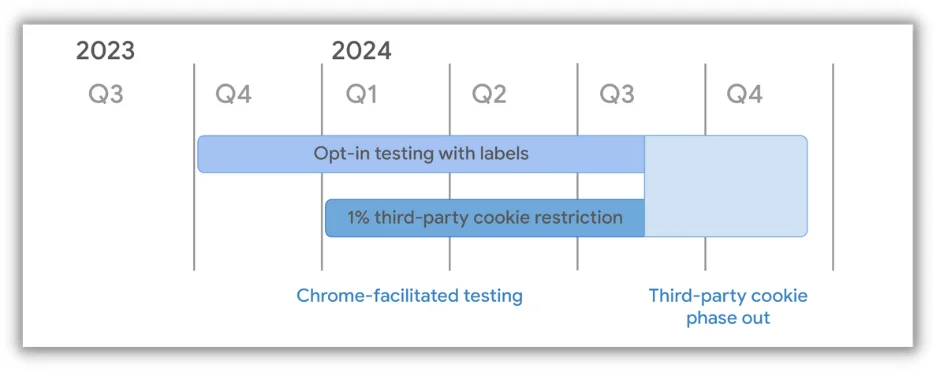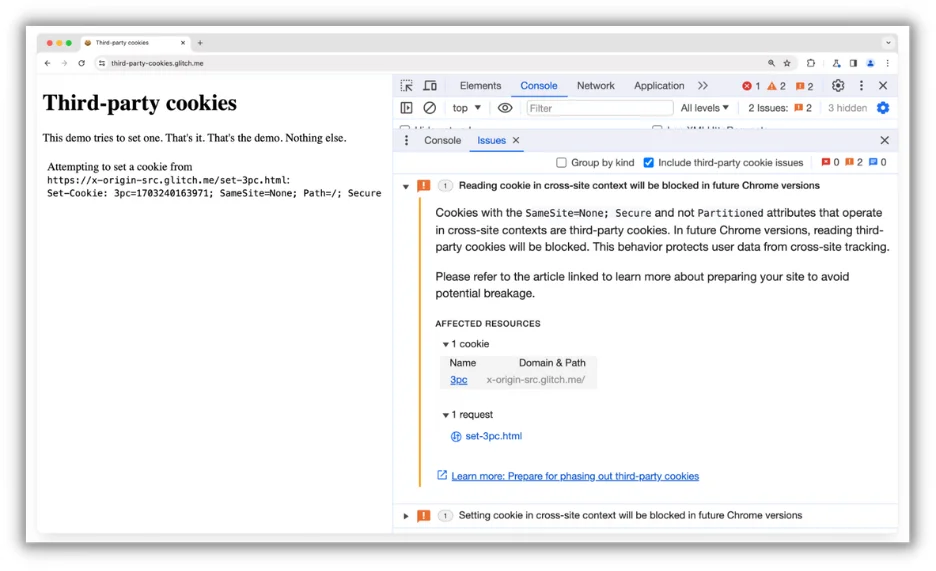For the last few years, Google has been preparing us for the deprecation of third-party cookies. And the time has finally come—Google began phasing out third-party cookies for Chrome users in January of this year.
The challenge: third-party cookies are what much of paid media relies on for performance tracking and targeting. So what can you do? Today, I’m going to walk through what you should be doing to prepare your PPC accounts for the removal of third-party cookies and what you should expect from your campaigns moving forward.
Table of contents
Is Google going cookieless?
The simple answer: Yes, eventually. As mentioned, in January of 2024, Google began phasing out third-party cookies for Chrome users with the plan to retire all third-party cookies by the end of the year. So far, it’s only impacting a small number of users, about 1%, but the plan for Google (and most other platforms) is to work away from third-party cookies.


If you want to know more about the timeline for the third-party cookies phase-out, you can read this article.
Why is Google getting rid of cookies?
Google is going cookieless to address privacy concerns from users who want to limit how they’re tracked online, what information is collected about them, and how their information is used.
“We continue to invest in features that protect your data and provide more control over how it’s used. This includes taking steps to limit the ability to track your activity across different websites,” Google said.
How to prepare your PPC accounts for the end of third-party cookies
So how can your PPC campaigns succeed in a cookieless world? Here are some steps to take to help.
? But, first! Is your Google Ads account set up correctly? Download now >> The Last Guide to Google Ads Account Structure You’ll Ever Need
1. Review existing cookies to know what will be removed
Not all cookies that are added to your sites function the same way. Some will be fine and can stay, and others will be ignored/removed moving forward. The good news is that you and/or your developer can audit your existing cookies to find out which ones will cause issues and need your attention and which ones you can leave alone.


To start the audit process, follow the steps in this article. There’s even a YouTube video to walk you through it. There are a couple of options you can use. First would be through Chrome Developer Tools.


The second is with a custom Chrome Extension Google created called the Privacy Sandbox Analysis Tool.
Either of these routes will help you identify which of your cookies need to be addressed and which will be compliant with the phase-out.
2. Take action for all third-party cookies based on platform
Unfortunately, Google is only making the change to ignore third-party cookies. It’s not providing solutions for the platforms using them.
Here’s the text Google provides for next steps:


Essentially, it’s up to your platforms themselves to find solutions to the cookie phase-out. Depending on which ad platforms you use, you can conduct some quick searches to see what they suggest you do to help avoid tracking breakdowns, but on the whole, there are really two large shifts that most platforms are suggesting advertisers embrace and a few tactics to employ them, which we’ll cover next.
3. Embrace first-party data
The first large shift requires advertisers to take data collection into your own hands. Rather than rely on the platforms provided third-party tracking, generating first-party data will help alleviate some of the privacy concerns with cookies.


That’s because in a first-party relationship, the user directly provides their information to a company. It’s not inferred or shared through a source that’s external to the interaction between the brand and customer, like a Google pixel is.
There are quite a few ways to generate first-party data for your business. Rather than go too far into detail here, I’ll let Joe Martinez give you some ideas to get started.
? Worried you’re wasting spend in Google Ads? Find out with a free, instant audit >> Google Ads Performance Grader
4. Use first-party data the right way in ad platforms
I want to give you some ideas of how that first-party data can be used in the ad platforms.
Customer match or audience uploads
Whether it’s Google Customer Match, Facebook Custom Audience Uploads, or a similar solution for another platform, most ad channels now let you import your CRM data into the system to match back to logged-in users. So any information you gather about your customers can be used to track them and create audiences of targetable users later on. (Again, see Joe’s article for ideas on how to generate that user information.)
Conversions API, enhanced conversions, and offline conversions
While Customer Uploads are for audience generation and targeting, these solutions are focused on performance and conversion tracking.
Conversions API is Facebook’s solution for tracking in-platform performance by matching back to user attributes tracked in your CRM. This process usually takes the assistance of a developer, but here are the steps to implement it.
Enhanced Conversions are a solution for Google Ads where user data provided on your website is hashed and sent back to Google privately. This relies on some tagging with the Google Site Tag but is compliant with these shifts as all information is anonymized before being shared. This can be done in a few ways: using your Google Site Tag or through Google Tag Manager.


Lastly, Offline Conversions from Google are similar to Facebook’s Conversions API where your CRM data is used to match to logged-in users on Google and track conversion performance. Usually, these are used for conversion actions that do not take place on a website, like a purchase of a service after receiving a quote online, but they can be used to fill in gaps in online conversions in some instances. Here’s a rundown of Offline Conversions with some helpful links to get you set up.
With these three suggestions, you’re now focused on gathering data through a first-party relationship and leveraging it in your accounts for more accurate audiences and performance tracking, but these solutions aren’t going to be foolproof. There will always be gaps. Additionally, this doesn’t address the other side of the equation: how you find users to target in the first place. That’s where our second shift comes into play.
5. Embrace AI and machine learning
It seems like these have been the hot topics for the last five years, but they’re more important than ever in a world with increasing privacy restrictions. Unfortunately, one of the key ways most of the amazing targeting we’ve gotten used to over the last two decades was through third-party cookies. Now that those are being phased out, we need to find a new solution.
As Google puts it, we need to move into an “Era of Prediction.” The platform algorithms have arguably been better at finding customers for many businesses in the last few years, but with the removal of third-party cookies, this gap between their abilities and ours as advertisers will get even wider.
Google is continuing to push broad match keywords coupled with Smart Bidding on Search but also suggests starting new campaigns with Maximize Conversion bidding strategies, even if your account isn’t meeting the traditional 50 conversions in 30 days threshold.


Facebook is also pushing its Advantage+ Audience targeting where advertisers suggest interests, behaviors, and demographic data that Facebook uses as a guide, but willingly goes beyond to meet campaign and ad set level objectives. Sound familiar?


For Google, that type of targeting is mostly associated with Performance Max and Demand Gen campaigns, Google’s new favorite solutions for everything that use Audience Signals to get started, but then target users through machine learning that it thinks will hit performance goals.
Whether it’s machine learning for targeting or bidding optimizations, it’s going to be imperative for advertisers to embrace AI in some way, shape, or form, to continue to see success with campaign performance.
? Want to use AI the right way? Free download >> Emergency Guide to AI in Marketing
What should you expect next in this cookieless future?
Once you’ve completed all of these changes for your accounts, or at least the ones that are applicable, it’s still going to be an adjustment as none of the solutions will be as “perfect” as the current setup. (I put “perfect” in quotes because anyone who has ever tried to nail down proper attribution knows there’s no “perfect” solution at the moment.)
Overall, here are the things I suggest you prepare yourself for in the future:
- Shift advertising focus to first-party data.
- Plan to utilize your CRM/internal tracking to understand campaign performance, but also know that…
- Performance tracking will not be perfect, or likely close to as good as it is now.
- Embrace machine learning and AI for targeting and bidding optimization and expect to rely less on manual inputs.
Prepare your PPC accounts for a cookieless future
The shift away from third-party cookies is underway and there’s nothing we can do to change that. All we can do is be good stewards of the ad accounts we manage and work to set them up with as many options as possible moving forward. Keep an eye on the news for the ever-changing landscape of online privacy and make sure you’re not falling behind.
And remember to follow these expert tips to prepare your PPC campaigns for a cookieless future:
- Review existing cookies to know what will be removed
- Take action for all third-party cookies based on platform
- Embrace first-party data
- Use first-party data the right way
- Embrace AI and machine learning